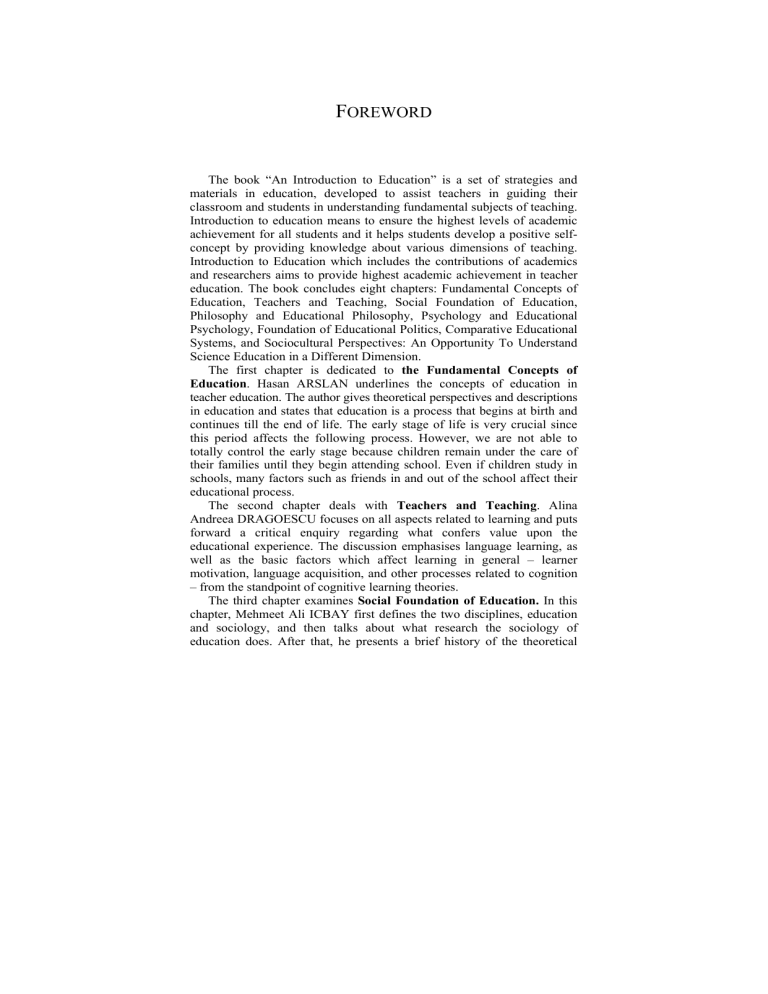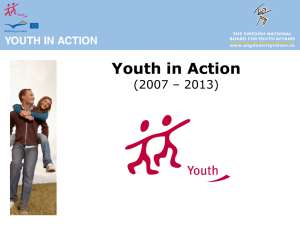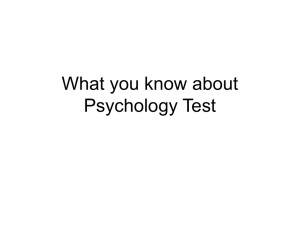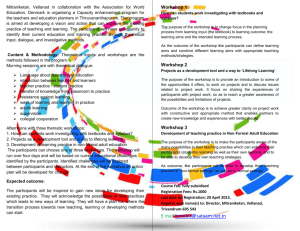
FOREWORD The book “An Introduction to Education” is a set of strategies and materials in education, developed to assist teachers in guiding their classroom and students in understanding fundamental subjects of teaching. Introduction to education means to ensure the highest levels of academic achievement for all students and it helps students develop a positive selfconcept by providing knowledge about various dimensions of teaching. Introduction to Education which includes the contributions of academics and researchers aims to provide highest academic achievement in teacher education. The book concludes eight chapters: Fundamental Concepts of Education, Teachers and Teaching, Social Foundation of Education, Philosophy and Educational Philosophy, Psychology and Educational Psychology, Foundation of Educational Politics, Comparative Educational Systems, and Sociocultural Perspectives: An Opportunity To Understand Science Education in a Different Dimension. The first chapter is dedicated to the Fundamental Concepts of Education. Hasan ARSLAN underlines the concepts of education in teacher education. The author gives theoretical perspectives and descriptions in education and states that education is a process that begins at birth and continues till the end of life. The early stage of life is very crucial since this period affects the following process. However, we are not able to totally control the early stage because children remain under the care of their families until they begin attending school. Even if children study in schools, many factors such as friends in and out of the school affect their educational process. The second chapter deals with Teachers and Teaching. Alina Andreea DRAGOESCU focuses on all aspects related to learning and puts forward a critical enquiry regarding what confers value upon the educational experience. The discussion emphasises language learning, as well as the basic factors which affect learning in general – learner motivation, language acquisition, and other processes related to cognition – from the standpoint of cognitive learning theories. The third chapter examines Social Foundation of Education. In this chapter, Mehmeet Ali ICBAY first defines the two disciplines, education and sociology, and then talks about what research the sociology of education does. After that, he presents a brief history of the theoretical viii Foreword framework. Starting with the classical works by Durkheim and Weber in the sociology of education, the chapter continues with the three turning points after the Second World War. The fourth chapter is dedicated to Philosophy and Educational Philosophy: Theoretical-Practical Considerations. Tomas BUTVILAS, Eva KRÁLOVÁ and Kęstutis TRAKŠELYS present theoretical and application. In the theoretical part, the authors mainly focus on existing philosophical schools of education while presenting six approaches that are still in use all over the world in classrooms in schools and auditoriums at higher education institutions. On the other hand, the presented educational philosophies give some basis for describing real educational activities with children and adults in both country cases. Another chapter on Psychology and Educational Psychology by Mirela SAMFIRA argues why is psychology important in the field of education? While the question is a simple one, the answer is much more complex. Information in the field of psychology is extremely important in almost all human fields where humans exist. The goal of this chapter is not to debate the role and importance of psychology in humans’ life, but to emphasise its applications in the field of education. The sixth chapter draws attention on Foundation of Educational Politics. Ferda BEYTEKİN provides a historical, philosophical, political, and sociological reflection on the relationship connecting education with sociology, culture, anthropology, politics, and economics. Education policy refers to the collection of laws and rules that govern the operation of education systems. The seventh chapter focuses on Comparative Educational Systems. Sari HOSOYA states that an educational system is political to some extent. When the objectives of education behind the educational system are suitable for the social environment and the needs of the people, the system functions quite well. On the other hand, if it does not match the needs, it does not work effectively. The government is required to balance the aims of the educational system and the needs of the people thoughtfully. The last chapter is written by S. L. Ramos-de ROBLES and A. J. Gallard MARTİNEZ. The authors draw attention on Sociocultural Perspectives: An Opportunity To Understand Science Education In A Different Dimension. The authors suggest that in the science education community in terms of ranking of importance, research into the social and cultural aspects of teaching and learning is second to the cognitivist who seems to mainly use positivism as a way make sense of data. Hasan ARSLAN CHAPTER ONE FUNDAMENTAL CONCEPTS OF EDUCATION HASAN ARSLAN Education is a process that begins at birth and continues until the end of life. The early stage of life is very crucial since this period affects the following process. However, we are not able to totally control the early stage because children remain under the care of their families until they begin attending school. Even if children study in schools, many factors such as friends in and out of the school affect their educational process. The educational system focuses on children from pre-school until graduate education. Educational gains mainly shift from public to individual gains as they attend a higher level of school each year. That is why education is compulsory in the first 10 or 12 years for children. Otherwise, greater and more costly social problems would occur if we could not educate them to be good citizens. Durkheim (1956) states that "education is the influence exercised by adult generations on those that are not yet ready for social life" (p.71). In other words, the primary objective of education is to help children develop intellectual skills and improve their physical capabilities. Additionally, they should be motivated at school to acquire the moral values that are demanded by political society, because society may suffer some social problems and pay more to fix them if we do not help children achieve these objectives. Dewey (1897) believes that education functions properly when there is a relationship between the individual and the environment, and that the purpose of education is to live for today, not to prepare students for future living. Thus, firstly moral training should be offered and schools should serve "as a form of community". Additionally, education is not a part of life and it should be regarded as "a continuing reconstruction of experience". If children gain experiences at school, then they may be able to learn about real life and become prepared for the future. Therefore, "what kind of experiences will they gain?" and "how should we help them 2 Chapter One acquire these experiences?" are the questions that should be answered. Specialists study curricula in terms of grades and subjects in order to help children develop the expected behaviours to have a better society. Moore (2010) explains education in relation to the commitment by society to have a desirable type of individual and the expected values. Thus, children may have some expected characteristics, attitudes, knowledge and skills that society would like to see. The author states that an educated man should have the desired intellectual abilities and at the same time should be very sensitive about moral matters, mathematical efficiencies and have a scientific vision and a historical and geographical perspective. When we look at society, it seems that the educational system has not been successful in training the expected educated man. Russel (1926) explains that education should provide children with a guide to allow them to develop their capabilities and skills. An education system should offer children, be they boys or girls, the opportunity to receive the highest level of education. Furthermore, Durkheim (1956) underlines that the focus and primary function of education is to prepare children for their roles as workers and members of a larger society and identifies the purpose of education as the shaping of the social being. Formal and Non-Formal Education Education can be divided into two categories: formal education and non-formal education. There is no certain line to distinguish one from the other because formal education to some extent consists of non-formal education. Children learn not only at the classroom but also from each other at the school environment. Formal Education Formal education (Ngaka, Openjuru and Mazur 2012) denotes a "hierarchically structured and chronologically graded educational system", which starts at pre-school and continues through university and includes "academic studies, a variety of specialized programs and institutions for full-time technical and professional training" (p. 110). Children, families, and adults voluntarily participate in formal education because they believe that formal education will provide a certificate or diploma for their children, and these official documents will help them receive a higher level of education and to build a better professional career. If unemployment is high and there is high competition for employment, then there will be a higher demand for formal education. Fundamental Concepts of Education 3 It might be speculated that governments are pleased to see that people demand more formal education and people to see that they get better employment opportunities at the end of formal education. Contrarily, if people cannot get better opportunities and positions when they graduate, they may lose their desire to continue with and participate in formal education. This may cause crucial problems in society. Non-Formal Education Non-formal education (Ngaka, Openjuru and Mazur 2012) refers to that type of education which does not take place in formally structured schools "such as adult literacy and continuing education programs for adults and out of school youth which does not necessarily emphasize certification" (p. 111). Non-formal education may cause children to develop desirable or undesirable behaviours. The environment plays a crucial part in this point. Even if it is impossible to monitor students out of school, parents should know where their children play and with whom they spend time. On the other hand, children may develop some unexpected behaviours even in a formally organized school while playing with friends at breaks (MoNE of Turkey 2016). Non-Formal Education: Non-formal education is intended for citizens who have never entered the formal educational system to develop their skills, e.g. in order to have a better professional career. Additionally, nonformal education may accompany formal education and may appear in many different forms. For example, improving reading and writing skills of citizens, professional development in a specific field, learning about a healthy life style, teaching socialization processes to immigrants and acquiring the habit of spending time productively is non-formal education. The differences between formal and non-formal education can be seen in terms of the purpose, timing, content, delivery system and level of control (p.111). Chapter One 4 Table 1. Ideal Type/Models of Formal and Non-formal Education Differences Purpose Formal Education - Long-term and general – Certified Timing - Long cycle/preparatory/fulltime - Standardized/input centred- Academic - Entry requirements determine clientele Content Delivery system Control -Institution-based, isolated from environment -Rigidly structured, teacher-centred and resource intensive External/hierarchical Non-formal Education - Short-term and specific - Certificate not necessarily the main purpose - Short cycle/recurrent/part-time - Individualized/output centred - Practical - Clientele determine the entry requirements -Environment-based and embedded in the community -Flexible, learner-centred and resource efficient -Selfgoverning/democratic Source: Adapted from Simkins (1977: 12–15, cited in Fordham 1993) Learning, Teaching and the Teacher What is a "learning experience"? Nyagah (2010) expresses that learning refers to the encountering interaction between the external conditions and the learner in the environment. Students have various interactions and are involved in some activities where learning takes place (UNESCO-IBE 2013). Learning: What is learning? How do we learn? Learning is not only a complex process, but also some kind of a long-term psychosocial process. Learning includes individual acquisition of competencies, behaviours, skills, values, and knowledge. Children acquire these attributes though instruction or experience. The learning process is explained with psychological and physiological approaches. The learning process can be described with three important models. These models are behaviourism, cognitivism, and constructivism. Briefly, behaviourism underlines a Fundamental Concepts of Education 5 measurable change of behaviours in the learning process. Environmental factors are very important for children and affect their behaviours. Cognitive theories focus on the internal mental structure of the knowledge that shapes children’s behaviours. Acquisition of knowledge and the processing of information happen through internal mental organization. The last model is constructivism which views the learning process as the addition of concepts and new ideas to existing knowledge and experiences (Kridel 2010). These learning theories highlight the changes in knowledge, understanding, skills, competencies and behaviours through environmental factors, internal mental actions or construction of new ideas. Learning is to feel different and to motivate individuals to explore new knowledge and ideas. Teaching: "There are diverse approaches to teaching which also implicitly reflect the approach to learning. The didactic approach mainly entails lecturing and is typically teacher-centred and content-oriented, i.e. teaching as transmission where the learners are considered to be passive recipients of information transmitted. Teaching can also be seen as supporting the process of learners’ knowledge construction and understanding, building on what is already known by the learner and involving a learner-centred approach (i.e. teaching as facilitation). Another approach emphasizes the development of learners’ cognitive processes and awareness and control of thinking and learning" (UNESCO-UNICEF 2014: 222). Teaching as a Profession Teaching is a professional job. Individuals spend most of their time in teaching activities either at school or at home. Teaching is a full-time job even if they spend 4-6 hours at school because teachers make preparations before going in class, evaluate students’ performances, assess exam papers and so on. Teaching covers all educational activities and teachers are responsible for children’s education. Teachers manage the teaching process and provide students information, knowledge and skills, and they teach students how to attain information, knowledge, and skills (Kadı, Beytekin and Arslan, 2015). They direct students’ activities over class time (Nyagah 2010). All educational systems focus on the importance of teaching. The question is how we can offer good teaching in class. This question reminds us of teacher education programs and the quality of education. Who can be a teacher? What kind of skills should be taught to them? According to Nyagah (2010), the following qualities make a good teacher: Chapter One 6 - spending most of his/her time with students, increasing their skills by learning new ideas continuously increasing their knowledge, being a good model for students and conducting their personal life with good character, having appropriate and adequate knowledge of his/her specialization, adapting to new circumstances and managing crises successfully at school. Durkheim (1956) describes a teacher as "the interpreter of the great moral ideas of his time and of his country" (p. 89). Teachers should have willpower and demonstrate confidence in their authority to transmit information. A teacher should be able to establish his authority without an external influence. In relation to the quality of teachers and teacher programs, Motivans, Smith and Bruneforth (2006) state that specific training is very important in teacher education if we desire to offer a good quality of education to students. Teacher quality requires "a range of motivation, competencies, and skills" (p. 49). In consideration of teaching as a profession, a teacher training program should include at least three aspects: general studies, subject-specific knowledge and pedagogical knowledge. Additionally, holding a knowledge of psychology, sociology, educational psychology, educational administration, curriculum knowledge, the education system, educational history, motivation theories, class management and school administration helps preservice teachers be "good" teachers. Preservice teachers need these various skills to develop themselves in order to answer students’ different questions because students ask questions not only in a teacher’s field but also in different subjects. That is why teacher training programs are very important to train individuals to be "good" teachers. Curriculum The term ‘curriculum’ comes from the Latin word ‘curere’ that means "to run a course". Therefore, the word denotes a subject which should have some special goals and produce outputs for learners. There are various kinds of courses in varying scopes. If there is a formal course, there should be a curriculum, too. Formal education cannot be established without a structured curriculum. There are different types of curricula and different types of descriptions in a curriculum (Nyagah 2010). The definitions of curriculum can be grouped into two: narrow definition and broad Fundamental Concepts of Education 7 definition. The narrow definition of curriculum is a plan and program. Learners follow a course and by the end of the course they have learned what the course is supposed to teach. The other definition is a broad one which sees curriculum as an educational process. This is a more comprehensive and longer process. The course reflects learners' social needs. The broader concepts consist of behaviours, values, attitudes, and experiences of students both in and out of school. Pratt (1994) states that the broad definition looks like a blueprint for instruction and incorporates teaching and learning processes. Curriculum describes each detail of teaching and learning process and attempts to answer what, why, and how questions. A good curriculum fosters quality of learning in schools. This is a systematic and intentional way to have expected results at the educational system (UNESCO, IBE 2011). A school tries to help students gain all learning experiences through the curriculum. Experiences are planned for children through their educational curriculum (Scottish Government 2009). Learning outcomes and some learning experiences are designed in order to teach children at school. Educational systems are intended to improve children’s knowledge and skills. To do so, they need a plan of action and curriculum, and the plan consists of teaching methods, learning objectives, assessments, learning content and educational materials. The system implements formal and non-formal education programs. Learning content consists of subject areas. These subject areas have no limitation. There might be on any subject. Learning objectives are targets for curriculum process. At the end of the process, students are supposed to develop attitudes and behaviours and to acquire skills and knowledge. Emotional, social, and cognitive development is promoted by educational activities. Teaching methods are tools to improve knowledge and skills. There are various teaching methods and techniques and teachers prefer these methods and techniques in terms of their teaching abilities and course targets and contents. Instructional materials help learners better understand courses. There are various teaching and learning materials such as books, maps, teacher’s guides, toys and supplementary resources. Assessment refers to a measurement tool in order to understand what has been learned from the course (knowledge, skills, attitudes…). Assessment helps teachers and learners understand how much course goal has been reached at the end of educational program (UNESCO International Bureau of Education 2016). 8 Chapter One A curriculum is a blueprint of learning and teaching and consists of many elements such as goals and objectives, content, teaching methods and techniques, learning activities and organization of learning experiences. The quality of teaching depends to the greatest extent on implementing curriculum elements which are strongly connected to each other. For instance, if you do not implement the right teaching method or technique in the classroom, it is not possible to reach the goals and objectives of a course. The educational curriculum has various dimensions. There might be formal or informal (hidden) structures. Learners should be helped to attain knowledge, beliefs, attitudes and some other desirable skills through an effective curriculum. The question is what knowledge, what beliefs and what attitudes should be taught to learners. Policy makers decide on the above questions on systemic scale and subject teachers decide on the above questions in terms of course goals. References Dewey, J. (1897). My Pedagogic Creed. The School Journal, LIV(3), 7780. Durkheim, É. (1956). Education and Sociology. New York: The Free Press. Fordham, M. (1993). On Not Knowing Beforehand. Journal of Analytical Pschology, 38, 127-136. Kadı, A., Beytekin, O.F. and Arslan, H. (2015). A Research on the Burnout and the Teaching Profession Attitudes of Teacher Candidates, Journal of Education, and Training Studies, 3(2), 107-113. Kridel, C. (2010). Encyclopedia of Curriculum Studies. California: Sage Publications. MoNE (2016). National Ministry of Education. Ankara: Ministry Publication. Moore, T. W. (2010). Philosophy of Education: An Introduction. London and New York: Routledge: Taylor & Francis Group. https://doi.org/10.1108/eb016334 Motivans, A., Smith, T., & Bruneforth, M. (2006). Teachers and educational quality: monitoring global needs for 2015. UNESCO Institute for Statistics. Montreal. Retrieved from http://scholar.google.com/scholar?hl=en&btnG=Search&q=intitle:TEA CHERS+AND+EDUCATIONAL+QUALITY+. Ngaka, W., Openjuru, G., & Mazur, R. E. (2012). Exploring formal and non-formal education practices for integrated and diverse learning Fundamental Concepts of Education 9 environments in Uganda. International Journal of Diversity in Organisations, Communities and Nations, 11(6), 109–122. Nyagah, G. (2010). Curriculum Studies. African Virtual University. Retrieved from http://oer.avu.org/handle/123456789/73 Pratt, D. (1994). Curriculum Planning: A Handbook for Professionals. London: Harcourt Brace College Publishers. Russell, B. (1926). On Education. Routledge: Taylor & Francis Group. UNESCO-IBE. (2013). Glossary of curriculum terminology. UNESCO. Retrieved from http://unescochair.blogs.uoc.edu/wp-content/uploads /2016/03/Glossário-UNESCO-inglês-1.pdf UNESCO International Bureau of Education. (2016). What Makes a Quality Curriculum? Retrieved from http://unesdoc.unesco.org/images/0024/002439/243975E.pdf.


